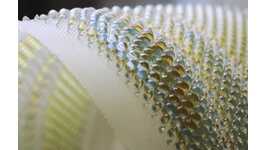
This Design Studio Has Created 4D-Printed Garments and Jewelry
Jessica Rosenkrantz and Jesse Louis-Rosenberg from design studio Nervous System have created a new way of making jewelry and garments using 4D technology. Working with computer simulations to create extremely unique and futuristic looking designs, the designers have created pieces that were printed using a 3D printer, allowing the designers to change the shape and structure of the jewelry and clothing.
Through the use of 4D technology, a process that involves printing primarily three-dimensional models or objects that can transmute from one form to another, the finished work is able to automatically assemble itself or mutate to become its predestined structure.
"4D printing refers to 3D-printing something in one shape that is intended to be in another shape," says Jessica Rosenkrantz, the creative director of Nervous System.
Through the use of 4D technology, a process that involves printing primarily three-dimensional models or objects that can transmute from one form to another, the finished work is able to automatically assemble itself or mutate to become its predestined structure.
"4D printing refers to 3D-printing something in one shape that is intended to be in another shape," says Jessica Rosenkrantz, the creative director of Nervous System.
Trend Themes
1. 4D Printing - The use of 4D technology allows for the creation of objects that can transmute from one form to another, opening up opportunities for self-assembling and shape-changing products.
2. Futuristic Design - 3D-printed jewelry and garments with unique and futuristic designs offer disruptive innovation opportunities in the fashion and accessories industry.
3. Computer Simulations - Utilizing computer simulations to create intricate designs provides possibilities for the development of new simulation software and design tools.
Industry Implications
1. Fashion - 4D-printed garments and jewelry present disruptive innovation opportunities in the fashion industry, allowing designers to create unique and customizable products.
2. 3D Printing - The use of 4D technology in 3D printing opens up opportunities for advancements in additive manufacturing and the development of shape-shifting 3D-printed products.
3. Simulation Software - The integration of computer simulations into the design process creates potential for disruptive innovation in simulation software and its applications across various industries.
2.8
Score
Popularity
Activity
Freshness















